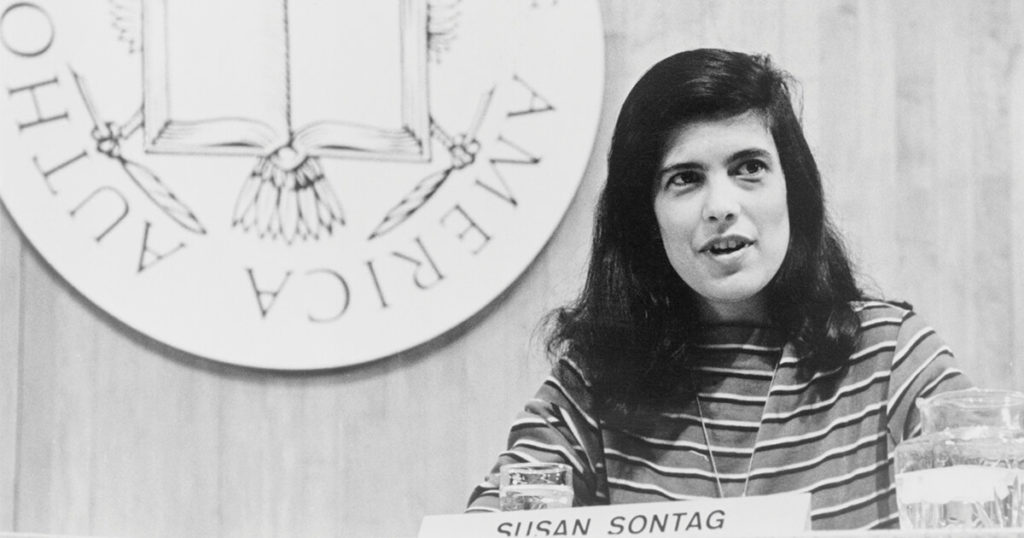
Sontag: Her Life and Work by Benjamin Moser; Ecco, 832 pp., $39.99
No verbiage mars the visual immediacy of Sontag: Her Life and Work. The biography’s cover is filled entirely by a photograph of its subject, a cynosure of American cultural life from the 1960s until her death in 2004. An androgynous figure who might have been a fashion model if she were not an essayist, novelist, filmmaker, and activist, she is both seductive and defiant as she challenges the viewer with a knowing gaze. Sontag did, in fact, appear in an Absolut Vodka ad, and her glamorous image was captured by many of the most prominent photographers of her time, including Richard Avedon, Henri Cartier-Bresson, Robert Mapplethorpe, Irving Penn, Andy Warhol, and her longtime companion, Annie Leibovitz. The gap between image and reality—like the gap between Susan Sontag and the celebrity “Susan Sontag”—was her persistent theme, most trenchantly explored in her 1977 book, On Photography. Though rarely at a loss for words, she was, famously, “Against Interpretation,” preferring pictures to words but “reality” itself to either verbal or visual representations of it.
Sontag was a temperamental, imperious diva and, to many, a bully. In 1996, when Carl Rollyson and Lisa Paddock tried to write her life, she responded in fury, forbidding access to her papers and commanding her friends not to cooperate. Daniel Schreiber’s German biography, subtitled Geist und Glamour, appeared in 2007, but he, too, was handicapped by lack of access. By contrast, Benjamin Moser, the biographer and champion of Brazilian novelist Clarice Lispector, has been able to examine letters and diaries and interview almost everyone with anything worth telling. The result is not only the definitive study of a gifted and vain intellectual but also a fascinating account of changing wind patterns as recorded by one of the era’s most prominent weathervanes.
Susan Rosenblatt was five when her handsome, dashing father died. Nathan Sontag, who married her widowed, alcoholic mother, did not legally adopt her, but she took his name because it sounded less Jewish. As a 17-year-old at the University of Chicago, Sontag enrolled in a sociology course taught by 28-year-old Philip Rieff. Ten days later, they were engaged. The union lasted eight years and produced one son, David, whom Sontag treated as a peer rather than a child and alternately smothered and neglected. In 1959, the marriage also produced a book, Freud: The Mind of the Moralist, which made Rieff’s reputation, but which Moser demonstrates was ghostwritten by his wife.
Sontag was attracted to women more than men, and Moser offers a running account of her numerous liaisons with each. Prominent women included Liebovitz, Lucinda Childs, María Irene Fornés, Carlotta del Pezzo, and Nicole Stéphane. Male lovers included Warren Beatty, Joseph Brodsky, Richard Goodwin, Jasper Johns, and Robert F. Kennedy. She came of age before Stonewall, when homosexuality was still a transgression and a crime, and though she did not deny her attraction to women, neither did she publicize it or enlist in the growing gay rights movement.
Biographers, by endowing it with order and coherence, tend to create the illusion of inevitability to the jumble that is life. Sontag’s death from cancer was ineluctable, despite questionable surgeries that merely prolonged her agony. But Moser’s book notes how truly contingent was the “Susan Sontag” who emerged from obscurity with her 1964 essay “Notes on Camp.” Her adoption by the editors of Partisan Review and The New York Review of Books made her an icon among intellectuals. Patronage by Roger Straus, who offered her contracts with Farrar, Straus and Giroux even for books she never produced, powered her career. He, Leibovitz, and others provided financial support at crucial times. An unexpected invitation to come to Sweden and make a film at government expense initiated another branch of the Sontag enterprise. At other junctures, she seized the moment by visiting Hanoi in the midst of the Vietnam War, defending Salman Rushdie against a fatwa, and staging Waiting for Godot during the siege of Sarajevo.
When, attentive to movies, photography, and pornography, Sontag wrote that “[t]he discovery of the good taste of bad taste can be very liberating,” she was attacked by erstwhile allies for abandoning Arnoldian high seriousness and reducing all cultural products to the same crude level. However, not intent on vandalizing “high culture,” she affirmed her commitment to “the kind of seriousness whose trademark is anguish, cruelty, derangement.” She was drawn to Danilo Kiš not Jacqueline Susann, Rainer Werner Fassbinder not Ed Wood. Although she ignored space exploration, genome mapping, and environmentalism, Sontag was a voracious polymath, an inspiring paradigm of the independent thinker. Her lucid prose and freedom to ramble were the envy of many constrained by the pedantic conventions and niches of academe.
Hyperbole is the quicksand of the aphorist, who would swallow the universe in a single sentence. Sontag, who admired the terseness of John Cage and E. M. Cioran, sometimes stumbles with pithy provocations, such as “The white race is the cancer of human history.” Moser’s lengthy book cannot be faulted for succinctness, though he dispenses with Paul Goodman, about whom Sontag said, “[f]or twenty years he has been to me quite simply the most important American writer,” in less than two pages. Only occasionally, as when he declares that by 1967 The New York Review of Books “was the most radical publication in the country” (more radical than Berkeley Barb, The Black Panther, Liberation, or Radical America?), does his measured prose share what he calls Sontag’s “weakness for rhetorical pizzazz.” Though Toni Morrison, Philip Roth, and Gore Vidal all outlived her, Moser dubs Sontag “America’s last great literary star.” Now that books have receded to the periphery of the cultural universe, that star shines brightly still, from a galaxy far, far away.

